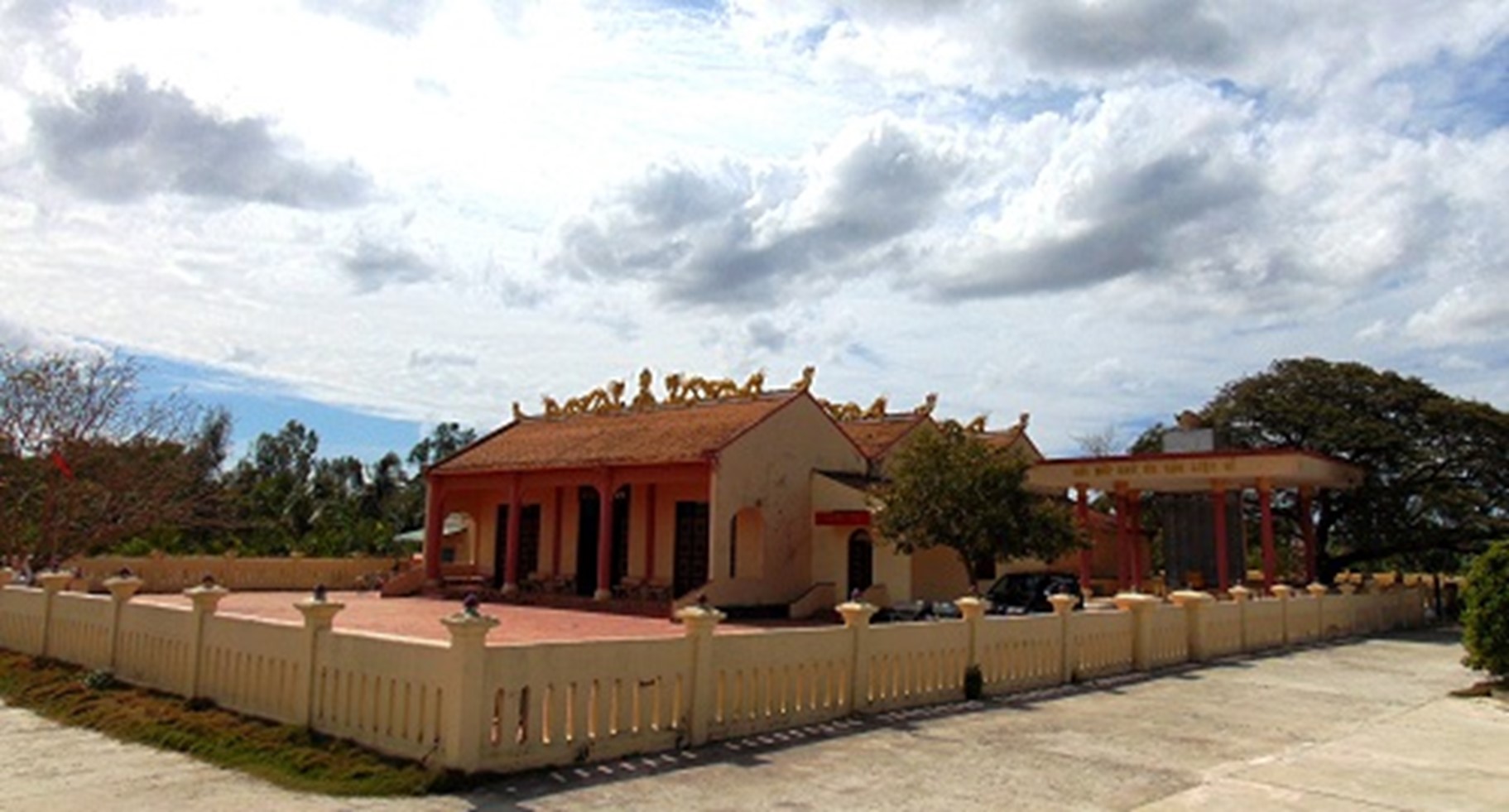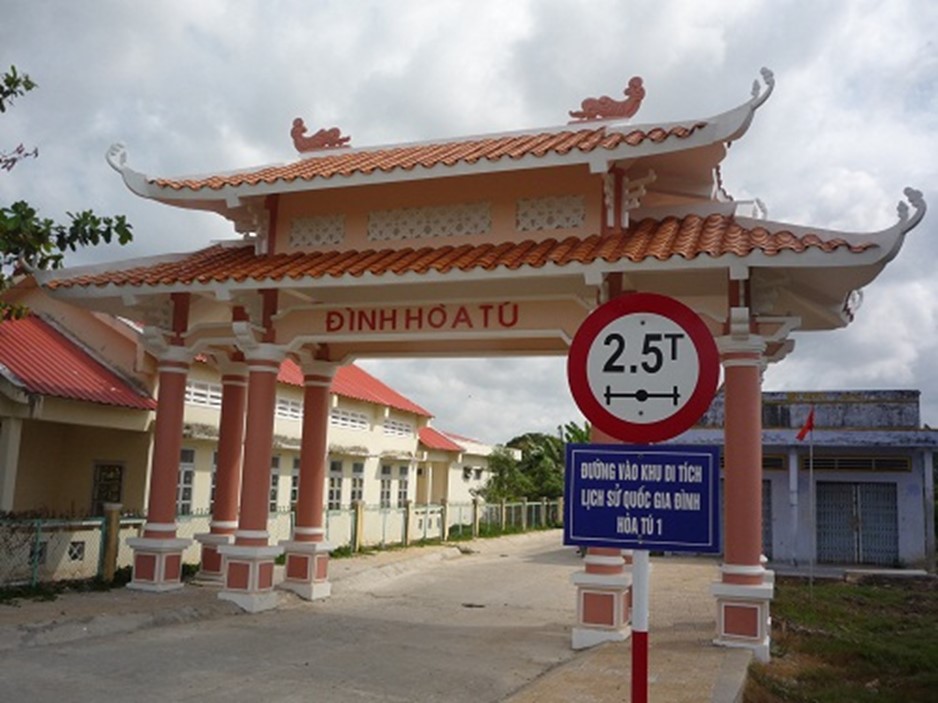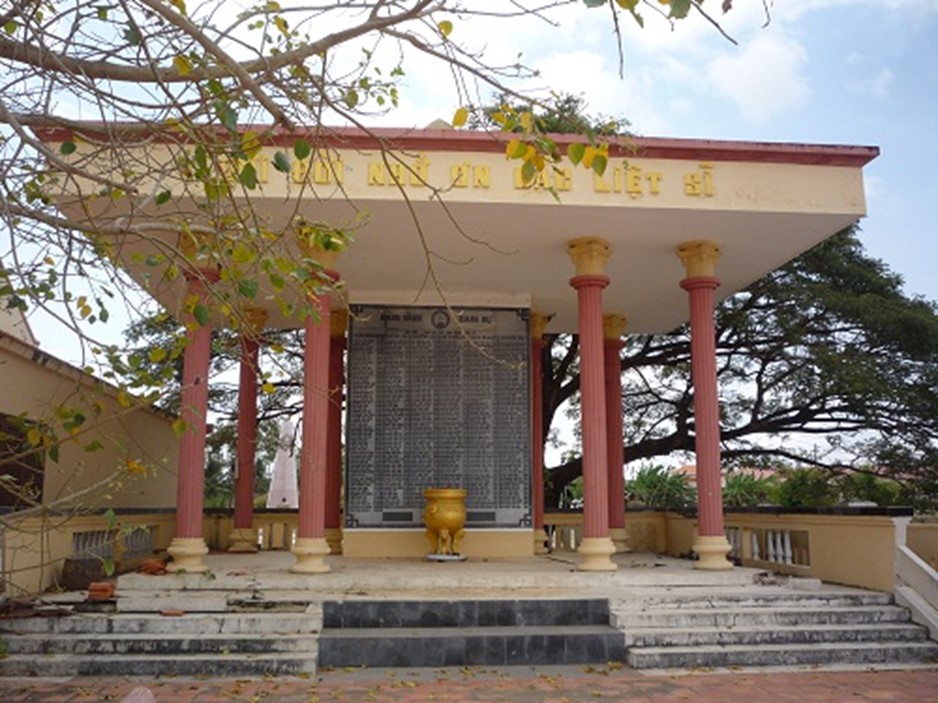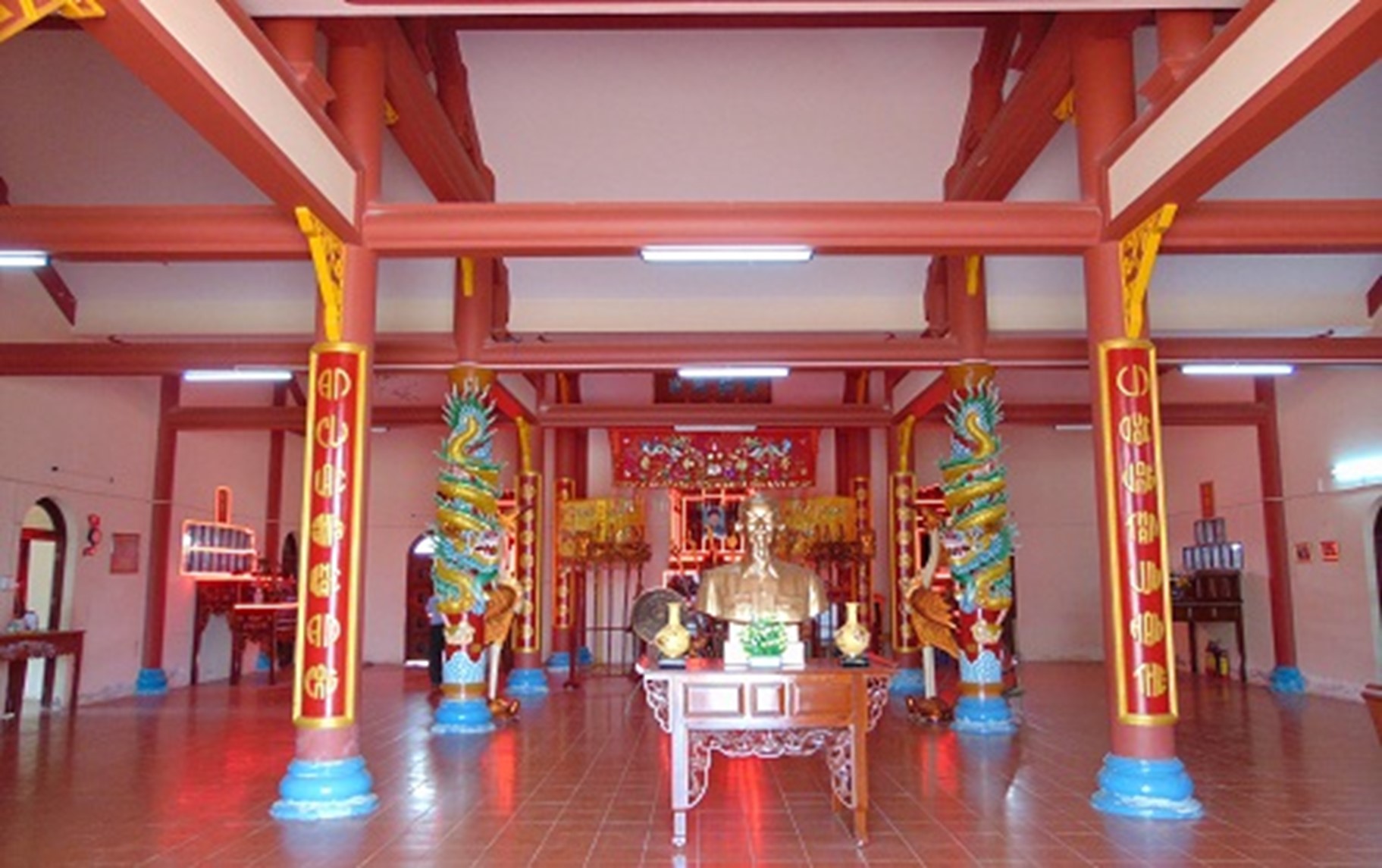
Hoa Tu Temple
The road to Hoa Tu Temple is convenient, both by waterway and by road. About waterway: from Soc Trang city to My Xuyen wharf, visitors go about 10km to Du Tho junction, turn right, go 7km to Rach Ro rivulet mouth, turn left, go to Rach Ro rivulet mouth about 6km to Hoa Tu Temple. Regarding by road, there are 2 directions: the first direction, visitors go from Soc Trang city to Provincial Road 8 (My Xuyen), go to Du Tho ferry about 6 km, cross the ferry about 6 km to Hoa Thuong - Ngoc Dong junction, turn right and continue for about 11 km to reach Hoa Tu Temple; the second direction, visitors go from Soc Trang city to Nhu Gia town, about 500 meters out of Nhu Gia town, there is a left turn road, go about 3.5km to Chang Re ferry, cross the ferry to continue (road 940) about 6km to Ngoc Dong - Hoa Thuong junction, turn left and continue for 2km to reach Hoa Tu Temple.

Gate to Hoa Tu Temple
The Temple was newly built in 2010, with 03 consecutive pavilions (symbol of number three in Chinese character), the gate of the Temple overlooks the northeast. The roof of the Temple is covered with yin and yang tiles. In The temple, the beam, ancestral tablets, altar, and parallel sentences were all skillfully carved. The first compartment is a martial arts space, the middle one is the guest house, the back one is the god shrine, there are 02 walls at the front edge of the Temple, which are 02 triangular troughs erected on top of the roof, built with cement bricks and were not decorated. The other two roofs, front and rear, are built with a slope. The entire Temple frame was cast with reinforced cement.

Stele of martyrs
On the roof of the martial house, along the ridge-beam is a statue of a two dragons adoring the moon, which was cast in reinforced cement, decorated with oil paint, each 1 m 20 long, dragons in a curved position (picture of a saddle), short horns, short tail, fierce face; Some of the couplets are in Vietnameseized characters, the rest are in Confucian characters.
Ancestral tablets of the characters who are worshiped in the Temple are those who contributed to the country, founded the village and associated with the revolt of Cochinchina in 1940. Among them, we must mention Comrade Van Ngoc Chinh – Secretary of the Party cell, who successfully led the revolts and this was also the first time when the red flag with yellow star flew on the roof of Hoa Tu village. After that, the insurgent army pulled back to Hoa Tu Temple to plan against the sweep and repression of the French colonialists.

Inside the main shrine
According to the history of the Party Committee of Soc Trang Province, Hoa Tu Branch was established in 1938, under the direction of Comrade Tu Boi, an officer of the Inter-provincial Party Committee and Comrade Van Ngoc Chinh, Secretary of the Party cell.
In September 1940, Japan entered Indochina, France surrendered to Japan. Our people once again had to endure the situation of two layers of domination and oppression. The landowners tried to exploit the people more and more. Their actions deepened the peasants' hatred for landlords and feudal colonists. Faced with this situation, the Party Committee decided to order the deployment of revolt throughout Cochinchina. At 2 pm of November 23, 1940, the order to deploy revolt of the Party Committee was received by the Hoa Tu Party cell through comrade Lam Thi Kim, and was delivered by comrade Nguyen Tan Dat. The time of simultaneous revolts throughout Cochinchina were set at 00 o'clock on November 23, 1940 but due to difficult communication, it took 14 hours to reach Hoa Tu.
Receiving the order, Comrade Van Ngoc Chinh immediately convened an extraordinary Party cell meeting at his house, it was too urgent so some comrades could not come in time. During the meeting, three main issues were agreed:
First, sending a quick contact to various hamlets to announce the concentration of forces that had been organized before, to gather at Temple village (namely Temple Hoa Tu) immediately to perform the departure ceremony.
Second, assigning each party member and key cadre to be in charge of anti-imperialist organizations, to promptly respond during the revolt process.
Third, giving orders to immediately arrest the henchmen including Vang, Tuan Ngo, Tuan Mai, who paralyzed Tuan Dinh's resistance, had Tuan Ngo knock at the door to arrest the village governor Tet. The Party branch nominated 06 people in the command board of the revolt including comrades: Van Ngoc Chinh (common commander), Tu Boi, Ha Thanh Nguyen, Ly Thanh Su, Tran Van Tan and Luong Don Que.
After The Communist Party cell had just finished meeting, on the night of November 23, 1940, the revolt force gathered in Hoa Tu with about 100 people and then grew up to 300-400 people with all social classes such as farmers, women, Caodaism followers, Catholics followers, teachers, employers for the landlords, elected troupes, Chinese originated people... from various hamlets of the village with rudimentary weapons tightly held in their hands: sticks, spears, Strikers, counters, hammers, gathered at comrade Van Ngoc Chinh's house. Before the departure of the army, Comrade Van Ngoc Chinh respectfully spoke to the insurgents and swore an oath: "Today, the Party Committee has decided that the entire Cochinchina region of Vietnam will rebel. In this Hoa Tu village, the Party cell and its people rebelled to destroy the Co Co fortress, forced the evil landlords to hand over the land to the tenant farmers, and at the same time our people stand up to seize power, swear to fight to the end, whatever the situation, we are determined to complete the task."
The revolt in Hoa Tu village broke out and won all of the planned objectives: destroying the village government apparatus, burning documents, confiscating a total of 7 guns (including 4 flamethrowers, 2 hunting guns and 1 air carbine) and some ammunition[1]. With rudimentary weapons and 7 guns just confiscated from the enemy and meager ammunition, the insurgents fought back stoutly. But in the end, with the overwhelming French military force and weapons, the insurgents had to withdraw, after Comrade Nguyen Van Loi died and a number of insurgents were captured.
By December 31, 1940, in the whole of Cochinchina, the French colonialists arrested 5,848 people[2], 187 people of whom were from Soc Trang, mainly insurgent soldiers in Hoa Tu and some in An Lac Thon, Ba Trinh, Chau Khanh, Soc Trang province. The colonial court sentenced and exiled 36 people to Con Dao island, of which 16 were forever lying in the hell on the land of Con Dao island.
Since the French colonialists fired the first shot to invade our country on September 1, 1858 in Da Nang, the Cochinchina organized revolt on November 23, 1940 directed the unification of the whole Cochinchina and was the General Rehearsal of the first armed revolt of the people of Cochinchina under the leadership of the Country Party Committee, against the French colonial rule and "the French colonial rule system has never been disintegrated, worn down, lost again. power, dismay as in the Cochinchina revolt”[3]. Therefore, although the revolt was suppressed by the French colonialists in a bloodbath, it "did not embarrass our people to fight, but only forged our people's hatred for the imperialists, trained more fighting spirit for continuing to struggle, how to wait for the opportunity to rise up to regain independence and freedom”[4].
With the great stature of the revolt, the people of Hoa Tu with their bare hands bravely rose up to fight for the liberation of their homeland, abolishing the chains of slavery, highlighting the role of the Party cell headed by comrade Van Ngoc Chinh. The revolt Cochinchina in Hoa Tu village, whose soul was the Hoa Tu Communist Party branch, will forever enter the history of the glorious struggle tradition of the revolutionary struggle history of Soc Trang province.
Comrade Van Ngoc Chinh was later conferred the title Hero of the People's Armed Forces. Particularly, the insurgent army of Cochinchina deserved the noble award by the Government of the Democratic Republic of Vietnam: "First-class Military Merit Order"[5].
Currently, Temple still preserves precious artifacts, such as: 02 wooden turtle shells, round statue, 40cm long; 02 wooden cranes, round statue, 40cm long, engraved with the epitaph of Chinese characters-ancient Vietnamese scripts, one was inscribed: "Bien Hoa provincial Chief Executive of US-China"; one was inscribed: "Worshipped by The Chief of Tan Trach village"; wooden legs of ancestral tablets in rectangle shapes of 4cm thick with carved patterns around the edges; A piece of wood carved with dragon shape hovering in the clouds of 3cm thick, size 20cm x 60cm; A piece of wood carved with a dragon's face spewing water of 3cm thick, size 25cm x 40cm; 01 double-barreled gun - a relic of the Cochinchine revolt in Hoa Tu village in 1940.
Every year, on the full moon day of the second lunar month is the day of worshiping "gods" which are attended by a large number of local people. They dress up boats with flags, drums, harps and trumpets to process the Book of Ordination into the main hall of the temple to place the Book of Ordination, then the opening ceremony and worshiping are performed. First of all, people make offerings to the gods and soldiers and Hoa Tu compatriots "sacrifice for the sake of the nation" and then pray for peace for humanity and for the local people.
Hoa Tu Temple was recognized as a national revolutionary relic pursuant to Decision No. 734/QD-BVHTT dated June 16, 1992 and is one of eight national monuments of Soc Trang province. Coming to Hoa Tu Temple, visitors will have the opportunity to learn more about the value of the relic, the tradition of struggle, and the patriotism of the soldiers and people of Soc Trang. Hoa Tu Temple is the pride of the Party Committee, of the army and of the people of the province and this is a place of traditional revolutionary education for young generations today and in the future./.